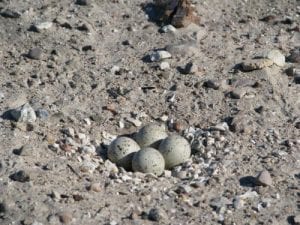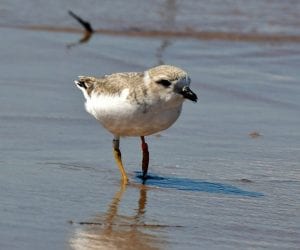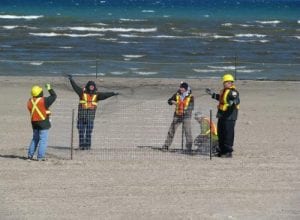Piping Plover

Plover adult and chicks (c) Neal Mutiger
Piping Plovers(Charadrius melodus)are listed as an endangered species in both Canada and the United States. The Piping Plovers at Wasaga Beach Provincial Park are part of the Great Lakes breeding population within the prairie sub-species. The 2007 arrival of the Piping Plover to Ontario was significant as this species had not successfully nested within the Province in over 30 years.
Historically, Piping Plovers were abundant along Georgian Bay and throughout the Great Lakes but their population began to decline rapidly after the Second World War as the demand for beaches for recreational purposes increased. By the time Piping Plovers were classified by Fish and Wildlife Services in the United States as Endangered in 1986, the Great Lakes population had reached an all-time low of 16 +/- nesting pairs.
The implementation of the Piping Plover Recovery Program in response to their elevated status on the Endangered Species list resulted in the population increasing from approximately 16 pairs to 76 in 2017. This increase would not have been possible without the recovery program nor, moving forward, will their population remain stable without the following procedures.
Identification: The Piping Plover is a small, migratory shorebird with a pale, dry sand coloured back and head, white underparts, and orange legs. These birds can blend in remarkably well with the beach around them. When in breeding plumage, the short bill is orange with a black tip, a single black band stretches between the eyes, and another single band runs across the breast. In breeding plumage both sexes appear similar. Their high-pitched ‘pipe’ call and habit of breeding on open sand or gravel beaches characterizes Piping Plovers.
Habitat: In general, Piping Plovers nest on wide beaches that have some gravel or cobble cover, some vegetative cover, and a large distance from nest site to treeline. Nests placed in sites with vegetative cover, and at a distance from the treeline provide adult birds with clear visibility over long distances. The nesting behaviour may be the result of predator avoidance strategy. The presence of shells or cobble may indicate higher ground that is less likely to be flooded and is therefore safer.

Piping plover nest scrape and eggs
Breeding: In the Great Lakes region, Piping Plovers arrive on their breeding grounds in late April and nests are usually initiated by mid to late May. In areas where several Piping Plovers are located, the birds may become involved in aggressive territorial interactions upon their arrival, including traversing their territory in both flights and runs. These traverses are interspersed with preening their neck ring to make it appear darker and wider and spanning the area. These small birds make their nests in the open part of the beach. Their nests are often just small depressions in the sand, holding up to four sand coloured eggs. They are vulnerable to storms, predators, and human traffic.

Juvenile plover (c) Neal Mutiger
Migration: It takes the chicks approximately 23-30 days to fly; after which they are considered “fledged.” While it varies each season, the chicks remain at Wasaga Beach Provincial Park for approximately six weeks following their hatch in June. After they leave Ontario in August, they quickly migrate to their wintering grounds on the Gulf of Mexico (most notably Florida) but there have also been reports of our chicks on the Atlantic coast. If the adults had a successful season with surviving chicks, the same pair will often migrate back to the same breeding grounds (i.e., Wasaga Beach Provincial Park) in April of the following year.
Predators: Plovers nest out in the open where they perfectly camouflage with the sandy beach. By the time the chicks hatch, the vegetation has regrown; thus, providing the necessary coverage needed to hide from the over abundance of predators on the beach. In the early years of the program it was noted that the lack of vegetation was directly correlated with the predation of young chicks by species such as gulls. Gulls, for example, are attracted to the beach by people as these birds search for a meal either by those who intentionally feed them or who unknowingly leave food out on their beach towels.
The Piping Plover Recovery Program

Piping plover and eggs (c) Neal Mutiger
With over one million people flocking to Wasaga Beach Provincial Park every year, it is crucial that an area compliant with the provincial guidelines is established for protecting the Piping Plovers while they are nesting on the beach. In addition to that area, it takes a team to help the successful recovery of Piping Plovers at the park. This team includes a Beach Stewardship Coordinator, volunteers, and park staff, as well as individuals from Bird Studies Canada, Canadian Wildlife Service, and the Ministries of Natural Resources and Forestry, and Environment, Conservation, and Parks.
You can be part of the team by ensuring good stewardship practices in regards to the species, including putting garbage in proper receptacles as the absence of trash limits the presence of gulls, which are a natural predator, and keeping dogs on a leash and away from the piping plover exclosures.
Annual monitoring begins as soon as Piping Plovers are seen on our beach. Daily monitoring begins at this time and staff and volunteers begin documenting foraging, territorial, and nesting activities. Once eggs are laid, perimeter fencing and educational signage are erected, followed by predator exclosures and further public education.

Perimeter fencing (c) Jim Beecroft
Perimeter Fences: Surrounding each nest, a 50 metre fence is temporarily installed each season using t-bars, rope, and signage. The location of this area varies each season depending on nesting birds. It is generally located in Beach Area 1 along the boardwalk but may also be erected in other Beach Areas, including New Wasaga and Allenwood Beach Areas. This fenced off area prohibits people from approaching the Piping Plovers while they are incubating their eggs, foraging, and rearing their young chicks.
Predator Exclosures: A wire predator exclosure is placed over the eggs to protect them from predators such as gulls, crows, foxes, and even people. The adults are able to freely enter and exit the predator exclosure so it does not impact their behaviour or their ability to forage.

Park staff preparing a nest exclosure
Piping Plovers lay their eggs every other day so with a clutch of four eggs, the entire process takes approximately one week to complete. With the first egg, a mini-exclosure is placed over this single egg as the process takes less than two minutes and thus does not scare away the nesting birds. The larger predator exclosure, which takes significantly more time, is placed after the fourth egg is laid as the birds are more invested at this point.
Banding: Approximately 98% of the Piping Plovers in the Great Lakes have a colorfully unique band combination which is used for individual identification. This allows us to accurately monitor the population as it fluctuates and to track individuals with each season. Chicks are banded by agency staff (Bird Studies, Environment Canada, and Ontario Parks) at approximately 8-12 days of age. Using these bands, we can track the movement of our Wasaga Beach chicks after they fledge (i.e., learn to fly) and migrate at the end of the season. We are excited, for example, to learn that our chicks are establishing new nesting sites across Ontario (e.g., Toronto Island, Darlington Provincial Park) and even into the United States (e.g., upstate New York, Pennsylvania). This spread signifies that our Recovery Program is successful as many of these new locations, though historical nesting sites, had not witnessed Piping Plovers within the last 80-100 years.
Program Success: Each season varies but overall, the Recovery Program at Wasaga Beach Provincial Park is an example on how a community can team together to save an endangered species from the brink of extinction. Involving groups of all facets, including non-profits, government agencies, the Town of Wasaga Beach, local schools and dedicated individuals who volunteer over 1,500 hours per season, the Piping Plover Recovery Program at our Park is a success.

(c) Neal Mutiger
